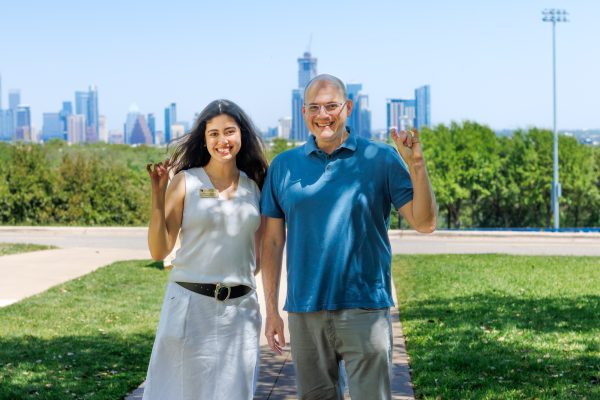University increases involvement, role in local nature preserve
The university is working to increase academic involvement in and public awareness of Wild Basin Wilderness Preserve, a nature preserve managed by St. Edward’s University in west Austin. Part of the initiative included renovations to infrastructure and changing the name of the building at the preserve to Wild Basin Creative Research Center.
Currently, Wild Basin consists of 227 acres of wilderness managed by the university, 65 of which are owned by St. Edward’s. St. Edward’s also owns a building on the property that contains classrooms, office space for employees and information for visitors.
“Everything that happens at Wild Basin begins in the building. That’s where hikers come in to pick up pamphlets, that’s where classes originate,” said Tom Mitzel, dean of the School of Natural Sciences and interim director of Wild Basin. “So the Wild Basin Research Center you can think of as just the building, but I think of it as everything emanates from that focal point.”
Wild Basin was designated as a preserve in 1974 and managed by a non-profit organization until 2009, when St. Edward’s took over management. Since the university began managing Basin in 2009, student research conducted at Wild Basin has been primarily science based and includes students from either the School of Natural Sciences or the School of Behavioral and Social Sciences.
“The goal is still to utilize academically as much as possible,” said Allan Hook, a biology professor and academic director of Wild Basin.
As the university is looking to expand academic outreach, the name change also reflects the goal to use the Wild Basin as an interdisciplinary laboratory for all five schools within the university.
“We have this preserve, why not use it, why not learn from it, and the thing is you don’t have to be from the sciences to use it,” Mitzel said.
Over the summer, the Wild Basin cirricula expanded to include a drawing class, and this semester’s Art in Public Spaces course is designing a new gate for a part of the fence that backs up to the surrounding neighborhood.
“Our hope is to really start to work with the public entities within our own academic program,” Mitzel said.
Next semester, the Humanities department will offer an art class called Wild Basin Wanderings as well as a photocommunications class, both of which will be taught entirely at the preserve. A research class called Wildlife Management at Wild Basin out of the School of Behavioral and Social Sciences will also be taught at the preserve.
The building, now the Wild Basin Creative Research Center, underwent renovations in spring 2012 in preparation for the change in use—from a visitor’s center to a small extension of the university’s main campus.
Renovations included rewiring phone lines and a complete overhaul of the heating, ventilation and cooling systems. There are now six computers in the classroom on the second floor, all of which are hooked up to the St. Edward’s server and wireless network.
“St. Edward’s has put an incredible amount of money into the infrastructure to make sure it works and that it works well,” Mitzel said.
Though the university intends to increase the number of students and faculty using the preserve for academic reasons, Wild Basin remains a protected nature preserve and a piece of the larger Balcones Canyonlands Preserve (BCP), a patchwork of protected lands in Travis County that includes 30,000 acres of land. All land in the BCP is managed as habitat for endangered species such as the Golden-cheeked Warbler and Black-capped Vireo.
For this reason, the university must obtain permits for research, classes and events hosted at Wild Basin. There is potential for research not just at Wild Basin but in the larger BCP area as well, where the university is working to obtain a general research permit.
“We want to be the gateway to the BCP in terms of research,” Hook said.
For now, the university is continuing to manage Wild Basin for what it is—a nature preserve—while increasing academic involvement and outreach.
“We’re very careful but we don’t want it to sit out there. We don’t want it to be a lost paradise,” Mitzel said.






